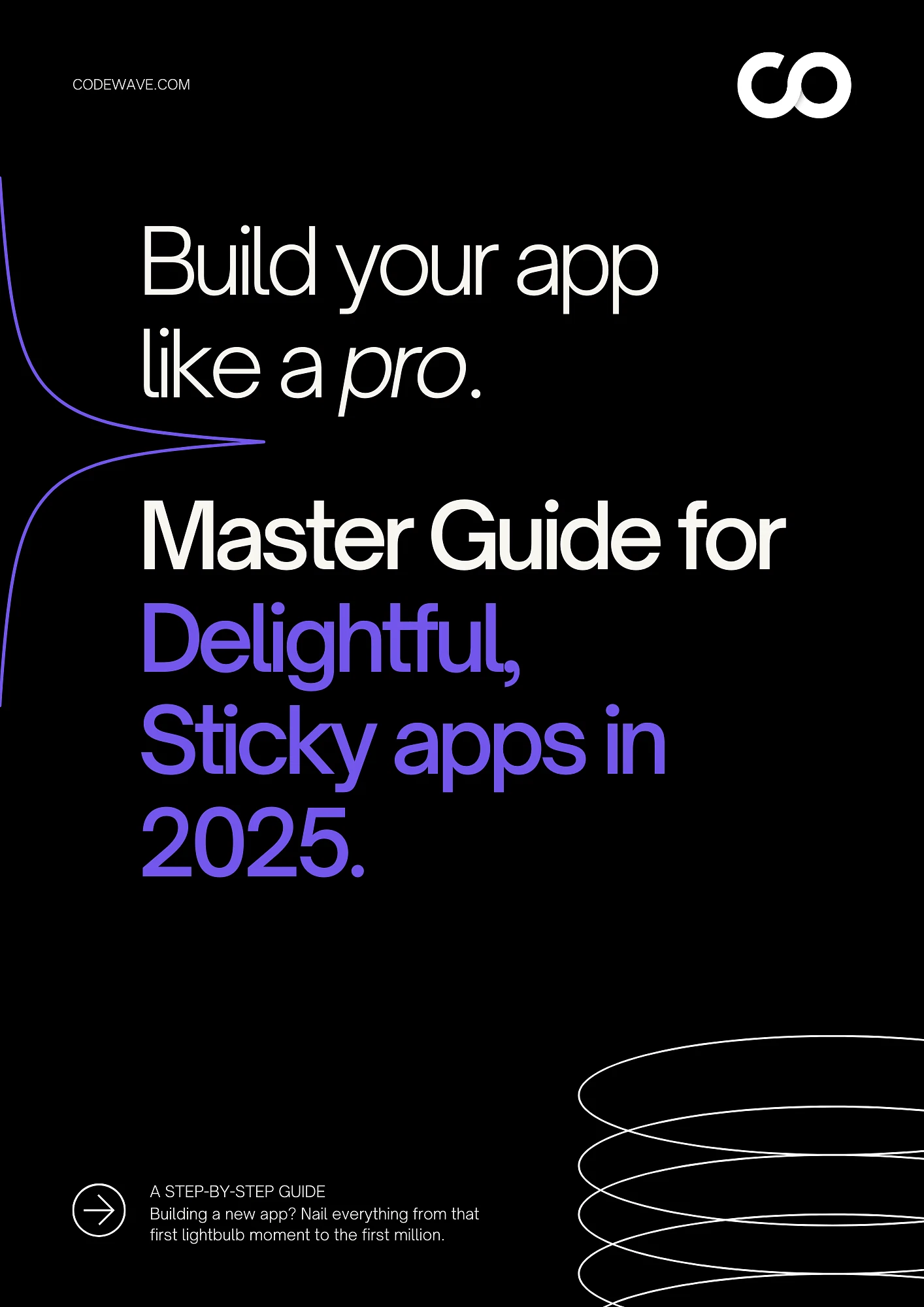Despite investing heavily in software, most enterprises still miss adoption, revenue, or efficiency targets. The core issue is misalignment: teams chase features, inherit legacy debt, and ship without clear measurement. Organizations expect their software-based revenue to reach 29% by 2030, up from 7% in 2022, which raises the bar for what development must deliver.
This blog lays out 10 application development strategies for 2025 that tie builds to outcomes: growth, efficiency, and customer value.
Key Takeaways
- Link every epic to hard targets like revenue per feature, churn reduction, conversion lift, and unit cost. Instrument from the first release.
- Use modular services, CI/CD, feature flags, and product analytics to ship small, measure impact, and stop work that does not move KPIs.
- Treat UX as a profit lever. Map the few journeys that drive money, fix friction, and track gains in conversion, retention, and support deflection.
- Add AI where math improves. Use personalization, anomaly detection, test automation, and code assistants with review gates to lower effort and raise relevance.
- Protect scale and spend. Automate security and compliance, apply FinOps basics, and design for multi-region growth without rework.
10 Proven Strategies to Maximize ROI from Application Development in 2025
Software spend is growing, but many apps still fail to deliver measurable returns. Features are shipped without a clear link to business value, architectures become expensive to maintain, and post-launch decisions often rely on assumptions rather than evidence.
The strategies below are designed to change that. They show how to build applications that align with business outcomes, scale efficiently, and generate sustainable ROI across the product lifecycle.
1. Define ROI Metrics Before Writing a Single Line of Code
A clear definition of success is the foundation of ROI-focused development. Instead of tracking surface-level metrics like downloads or session length, link every feature and release to direct business outcomes such as revenue, retention, conversion rate, or operational savings.
- What to implement: Tie every epic to one or two measurable outcomes and track them from the first release.
- Why it pays: Metrics guide technical decisions, prioritization, and budget allocation — ensuring resources go where they deliver measurable impact.
2. Shift from Feature-First to Problem-First Roadmapping
Teams often add features based on assumptions, resulting in bloated products that fail to address core user challenges.
A problem-first approach flips the process: identify pain points with revenue or retention impact and design solutions around them.
- What to implement: Rank problems by their business value and prioritize solutions that directly reduce churn or unlock revenue.
- Why it pays: Every feature shipped addresses a validated need, reducing waste and increasing adoption.
3. Build with Modular, Extensible Architectures
Applications built as monoliths are costly to maintain and difficult to evolve. Modular architectures, using microservices, containers, or composable components, reduce that burden and make scaling more predictable.
- What to implement: Structure your system so individual services can be built, deployed, and scaled independently.
- Why it pays: You lower maintenance costs, reduce technical debt, and accelerate feature delivery without major rewrites.
4. Shorten Feedback Loops with Continuous Delivery and Feature Flags
Speed and adaptability are critical for ROI. Continuous delivery pipelines, feature flags, and canary releases enable teams to rapidly deploy small changes, measure their impact, and iterate based on live user data.
- What to implement: Automate builds, tests, and deployments while controlling feature exposure to gather feedback safely.
- Why it pays: Teams improve product-market fit faster and reduce the cost of failed experiments.
5. Prioritize UX and CX as core business drivers
UX drives revenue by shaping conversion, retention, and satisfaction. Treat design choices as economic choices.
Set clear user goals, test flows early, and maintain a living design system to reduce variance across teams.
- What to implement: Run quick prototypes with real users, measure task success and drop-off, and tie each change to a target metric. Maintain a metric layer for shared definitions so product, design, and engineering read the same numbers.
- Why it pays: Improving critical journeys moves topline results. Baymard’s research shows checkout UX fixes can raise conversion by about 35 percent for large ecommerce sites, which translates into substantial recovered revenue.
Also Read: Top 11 Trends in Application Development for 2025
6. Integrate AI and Automation to Improve Performance and Reduce Costs
AI can automate repetitive tasks, deliver personalized experiences, and improve decision-making. When integrated into applications, it enhances functionality and reduces operational overhead.
- What to implement: Deploy AI for personalization, predictive insights, and anomaly detection in workflows.
- Why it pays: Manual effort drops and users get more relevant experiences, which drives ROI. McKinsey reports developers can complete coding tasks up to twice as fast with generative AI, reinforcing the direct productivity upside.
7. Use Analytics-Driven Product Decisions Post-Launch
The real measure of a feature’s success happens after launch, not before. Without continuous measurement, teams often continue to invest in features that users ignore or fail to contribute to core business goals.
Instrumentation and analytics turn product performance into a feedback loop, showing which ideas work and which should be cut.
- What to implement: Instrument every release with telemetry that tracks user behavior, engagement depth, and conversion paths. Utilize product analytics platforms such as Amplitude, Mixpanel, or GA4 to segment users, conduct cohort analyses, and assess the impact of each feature on defined KPIs.
- Why it pays: By directing resources to what creates value, ROI improves, and wasted development effort is reduced.
8. Design for Scalability and Global Reach from Day One
Applications that cannot scale quickly limit revenue potential. Designing with scalability and global reach in mind from the start helps support growth without expensive re-architecture later.
- What to implement: Choose cloud-native platforms, distributed data layers, and multi-region support early on.
- Why it pays: New users, markets, and workloads can be supported without ballooning infrastructure costs.
9. Automate Governance, Security, and Compliance Early
Security breaches, compliance violations, and manual audits drain ROI. Automating governance and security controls from the start keeps costs predictable and reduces regulatory risk.
- What to implement: Embed encryption, access control, and automated compliance checks in the development pipeline.
- Why it pays: You avoid costly incidents, accelerate audits, and protect customer trust, all critical for long-term ROI.
10. Adopt a “Product-Led Operations” Model
When the product becomes the center of go-to-market efforts, everything from sales to support aligns around delivering value through the application itself. Internal automation and self-service tools strengthen this alignment.
- What to implement: Build APIs, dashboards, and automation that empower internal teams to act on product data directly.
- Why it pays: Go-to-market efforts become faster, customer acquisition costs drop, and revenue growth accelerates.
Struggling to turn your app idea into a product users actually love? Codewave helps you bridge the gap between concept and impact with end-to-end mobile app development services at 30% lower cost. We cover everything, from strategy and design to build, launch, and scale.
Also Read: Analytics as a Service: Essential Steps for Implementation
Even the strongest plans meet friction in delivery. Let’s name some of the blockers and address them with targeted fixes.
Common Application Development Challenges And How to Solve Them
Even strong strategies miss ROI when teams underestimate structural and operational risks. Tackle these seven issues early to keep investment tied to measurable outcomes.
Challenge 1: Misaligned objectives between business and engineering
Roadmaps tend to focus on interesting features rather than revenue, retention, or efficiency.
Solution: Define ROI metrics before any build. Tie epics to outcomes such as revenue per feature, churn reduction, lead-to-sale conversion, cost per transaction, or support tickets avoided. Review every proposal against these targets in planning and in release reviews.
Why it matters: Organizations incur significant losses due to poor software quality and misdirected effort; in the US alone, the 2022 estimate reached $2.41T, with $1.52T of that in accumulated technical debt.
Challenge 2: Feature bloat that drains resources
Teams often overbuild. Large portions of functionality see little or no use, which slows delivery and inflates maintenance.
Solution: Run problem-first discovery. Validate features against a clear user pain and a business KPI. Utilize product analytics to identify and retire or re-prioritize low-use capabilities.
Why it matters: A frequently cited Standish analysis showed a majority of features see rare or no usage, underscoring the cost of building beyond verified needs.
Challenge 3: Technical debt slows delivery
Monoliths, tight coupling, and opaque dependencies increase change risk and cycle time.
Solution: Move to modular architectures with clear service contracts. Containerize workloads, separate compute from state, and standardize APIs and events.
Also Read: Building and Designing Secure Software: Best Practices and Development Framework
Challenge 4: Unclear or untracked ROI after launch
Post-release impact is not measured, so spending continues on features that do not move KPIs.
Solution: Instrument every release. Track key metrics, including adoption, conversion lift, cost per action, retention deltas, and support deflection. Use A/B tests and cohort analysis to prove cause and effect.
Why it matters: Companies that scale analytics effectively are 2.5x more likely to apply rigorous methods from model development through deployment, a marker linked with superior business performance.
Challenge 5: Security and compliance gaps that stall deployment
Controls are often added late, causing rework, delays, and audit risk.
Solution: Bake security into design and pipelines. Enforce least-privilege IAM, encrypt in transit and at rest, log every access, and automate policy checks mapped to GDPR, CCPA, HIPAA, or SOC 2.
Why it matters: The average global breach cost reached USD 4.88M in 2024, marking a sharp year-over-year increase. Preventive controls protect ROI and reduce incident exposure.
Challenge 6: Slow time to market from rigid processes
Manual QA, long change windows, and infrequent deploys delay the realization of value.
Solution: Adopt CI and CD with automated tests, canaries, and feature flags. Ship smaller changes more often, measure impact, and roll back quickly when metrics regress.
Why it matters: DORA’s 2023 research links healthier engineering cultures and modern delivery practices with higher organizational performance, supporting investment in continuous delivery and fast feedback.
Challenge 7: Limited scalability for growth and expansion
Apps that work in pilots falter under real load or new regions, forcing expensive rework.
Solution: Design for scale from the start. Use horizontal scaling, multi-region failover, CDN distribution, and data partitioning. Test for latency budgets and failover behaviors regularly.
Why it matters: Network and regional latency variations are material at scale. Planning with real performance data guides sound deployment choices and protects user experience.
Is your web platform struggling to deliver experiences that no longer convert? Codewave’s Web App Development services help you build modern, high-performing sites that engage users and drive measurable business results, all delivered 3x faster and at 30% lower cost.
From UX-led design and seamless omnichannel experiences to secure, auto-scaling architectures, we turn your web presence into a growth engine.
Also Read: Step by Step Guide to Mobile App Development for Businesses
With the core in place, look ahead to what will reshape delivery. These shifts influence budgets, team structures, and release speed.
Top Trends to Watch Beyond 2025
Software delivery is moving toward smarter automation, smaller deployable units, and streams of immediate signals.
These shifts change how you fund projects, how you organize teams, and how fast you can move from idea to impact.
1) AI-powered development copilots
Code assistants are moving from novelty to standard tooling. They draft functions, propose refactors, and generate tests, which shortens lead time and reduces repetitive work.
The win comes from adding clear guardrails, human review, and measurement. Track lead time, change failure rate, and escaped defects before and after adoption to prove value and tune usage across teams.
2) Composable frontends and BaaS replacing monoliths
Frontends are shifting to shared design systems and micro frontends, while managed backends handle common services like auth, payments, and notifications.
This lets teams ship independently and avoid rebuilding undifferentiated plumbing.
Keep costs and risks in check with versioned components, strong API contracts, and explicit exit paths, allowing you to switch providers without rewriting core flows.
3) Event-driven applications for real-time experiences and revenue
Applications are beginning to publish and react to business events in near real time. Streams power personalization, anomaly alerts, and usage-based offers while batch views continue to serve BI and ML.
The model works when you define freshness targets, monitor end-to-end latency and loss, and maintain a schema registry so producers and consumers stay in sync as volumes and use cases grow.
Also Read: Machine Learning App Development: A Complete Guide
Codewave x Creddinv: A Production-Ready Fundraising App for Pre-Seed Deals
Creddinv Technologies wanted a production-ready platform that lets pre-seed startups publish fundraises and investors discover, evaluate, and engage with deals, across web and mobile, with clear security, scale, and speed.
Problem:
New startups lack a direct channel to investors. Investors struggle to find and assess pre-seed ventures in one place.
Solution:
Codewave built Creddinv Technologies, an aggregator that connects pre-seed startups with investors. Startups raise capital through CSOP and venture debt, while investors filter, compare, and engage in a single workflow.
What we built (product surfaces)
Below are the user-facing apps and their roles:
- Web app (Next.js): Investor discovery, screening, shortlists, due-diligence workspace, admin ops.
- Mobile app (Flutter): Founder onboarding, funding updates, investor chat, document uploads.
- Backend (Node.js + PostgreSQL): Deal graph, profiles, instruments (CSOP, venture debt), permissions, audit.
Interested in similar projects? Explore more impactful digital products and platforms we’ve delivered in the Codewave portfolio.
Conclusion
Application development is no longer about how quickly you can ship code, it’s about whether that code moves revenue, retention, and operational efficiency. The strategies we’ve covered show that measurable ROI comes from clear metrics, modular architectures, automation, data-driven decisions, and a relentless focus on user value.
If you’re ready to stop wasting resources on apps that underperform and start building platforms that drive growth, Codewave can help. Our product engineering and digital transformation teams specialize in designing, building, and scaling applications that deliver measurable business impact from day one.
Talk to us about your goals, and let’s turn your next software project into a growth engine.
FAQs
Q: How do I set an ROI baseline for an existing app without stopping feature work?
A: Start with a 4–6 week measurement sprint. Instrument the top five journeys, publish unit costs (per signup, per transaction, per session), and tag current features to outcomes. Keep shipping, but route new scope through this lens so you can compare impact before and after.
Q: What is a practical way to decide build vs buy for common services?
A: Score each capability on differentiation, risk, and total cost over three years. Buy for non-differentiators like auth, billing, and notifications; build thin wrappers for portability. Reassess semiannually with usage and cost data to catch drift.
Q: How do I avoid BaaS or model vendor lock-in without slowing delivery?
A: Standardize on open interfaces. Keep an internal contract layer for identity, storage, and inference, and store prompts, features, and policies outside vendor silos. Run a quarterly swap drill on one low-risk path to prove you can switch.
Q: What metrics should a product team review weekly to keep ROI on track?
A: One north-star outcome (revenue, activation, retention), two journey KPIs per domain, and three health checks (latency, error rate, cost per request). Pair that with a short list of experiments and a kill or scale decision for each.
Q: How do I modernize a monolith without a long freeze?
A: Strangle by domain. Carve out one bounded context behind an internal API, mirror traffic, and switch callers when quality bars are met. Repeat in small slices while a reliability budget keeps the core stable and the team shipping.
Codewave is a UX first design thinking & digital transformation services company, designing & engineering innovative mobile apps, cloud, & edge solutions.







